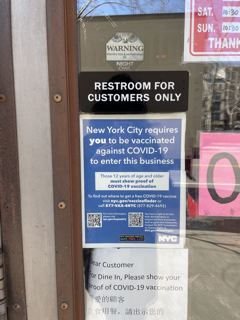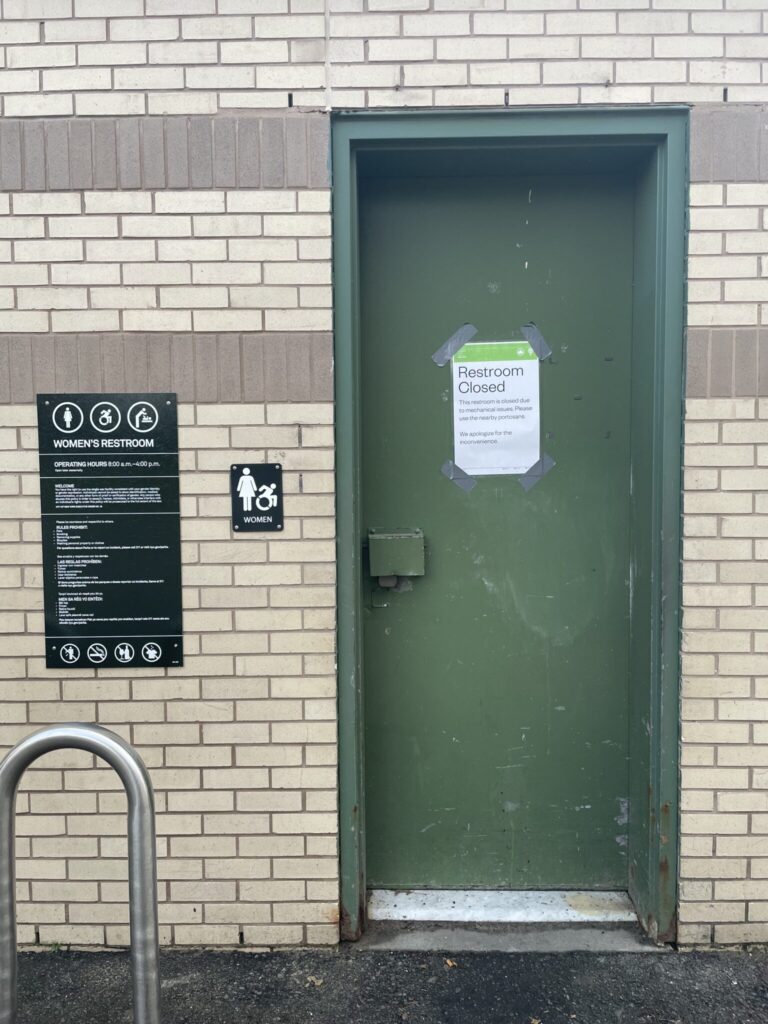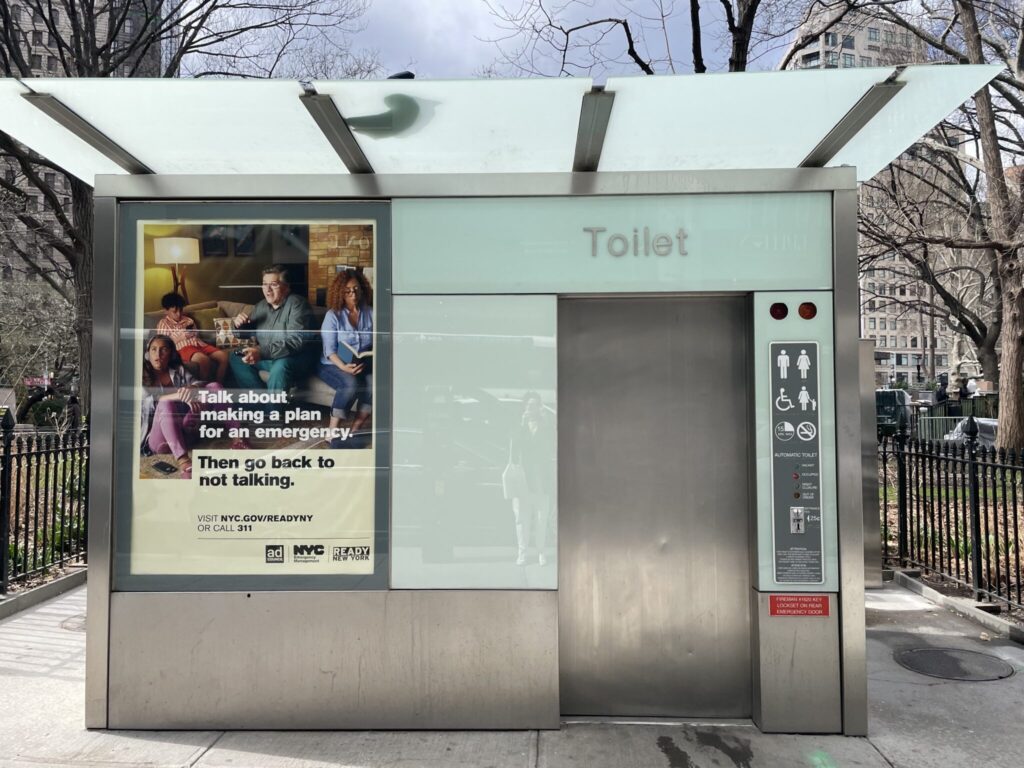MIRANDA BELLIZIA
Public bathrooms meet a need. They are more than toilets – they are spaces where people can collect themselves, change a child’s diaper, congregate with friends, or simply feel safe for a moment. However, bathrooms have also historically been spaces where those in power attempt to control citizens, removing their autonomy and, with it, their safety.

Bathrooms are points of contention and competition.
This contention and competition are heightened in New York City because there are not enough public bathrooms available. For a city with a population of 8.8 million people, close to one million daily commuters , and 66 million annual visitors, there are only 1,160 public bathrooms. Out of that already low number, only two are open and available 24/7.

Bathrooms are intersections.
Bathrooms are where basic human needs intersect with policy abuse and unequal power dynamics, as witnessed in the era of segregation and recently with the introduction of numerous transphobic bathroom bills. They are personal, but intrinsically linked to public safety; they can be wielded as tools of control, requiring individuals to determine where they are welcome and where they are not.
“Customers Only” sign on restaurant door, credit: Miranda Bellizia
A private business owner is able to make a decision about whether you have the right to use their facility — a right that is, or should be, a basic human right. This promotes discrimination against those who may already be most at risk, creating additional burdens and stress. On a more basic level, lack of bathroom access might mean the difference between a city dweller spending the day exploring their city or staying home.

Bathrooms can be places of respite.
Rather than replicating their historic uses of discrimination and control, bathrooms can allow people to rest and feel safe. Everyone should have the privilege of being able to tend to their basic needs, ideally with access to amenities that allow them to exit feeling and looking more refreshed than when they entered. Being able to move through the public realm without concern about where you will be able to stop to use a bathroom, tend to your child, or wash your hands, adds a much-needed element of comfort and safety to our experience as humans.

Bathrooms can be social spaces.
Bathrooms can offer rooms to retreat to with your friends, to gossip about what is going on in the outside world, safely away from the ears of others. Women’s rooms in bars and nightclubs are notoriously spaces where women make new friends, where the kindness of one woman helping another abound; where friends can offer each other, and sometimes strangers, compliments and support.
Bathrooms can be places of safety.
This sense of safety is created through prioritizing care in communities and shared experiences. The safety created in bathrooms comes from having access to privacy in public, and having a moment to solitarily meet your bodily needs. With safety comes an added sense of security, of not having to think about where or how to find a bathroom, and simply having the right to use one regardless of your means, ability, gender, sexuality, or age. Prioritizing care and not the creation of a more carceral state meant to protect private property above all else can ultimately produce a greater sense of safety and security.

New York City is ranked the safest city in the United States and among the top twenty safest cities list in the world. However, safety is subjective. Groups of people who are already marginalized within society are often those who face criminalization and discrimination most frequently– this pattern extends to sanitation citations. When police punishment comes into play, it is important to examine who is bearing the brunt of the summons. Time and time again, we see arrest and citation numbers at their highest within the city’s most impoverished neighborhoods.
Broken lock on stall in Union Square, credit: Miranda Bellizia
Bathrooms are places of privilege.
The lack of bathrooms across New York City highlights the connection between privilege and access, carving deeper edges in a city already dealing with growing inequality and barriers around access of all kinds. This privilege and safety is often not offered to people of color. Where white people may feel safe and at ease using facilities as they need, communities of color, who were historically forbidden access to many public spaces, still carry similar burdens today. With continued and new threats of systemic and structural violence, the knowledge that danger may be around any corner pervades those lacking privilege. These fears are realized through targeted policies carried out by the police and in social threats mounted by other members of society.
Similarly, people who identify outside of the gender binary often do not feel safe in public spaces due to similar historical discrimination and stigma. This fear is particularly exacerbated when access to bathrooms comes into question due to the binary nature of how bathrooms are labeled as either male or female. Threats – whether perceived because of statistics, or felt first-hand – diminish feelings of safety in the public realm.

Bathrooms are policy opportunities.
Having access to clean bathrooms whenever they are needed – by all persons, regardless of one’s race, gender, sexuality, ability, or age – would increase safety and security for all in the public realm. Bathroom access provides acceptance, respect, and fosters community and connections, if granted without boundaries.

Bathrooms are not just toilets; they are a portal to feeling clean and comfortable, to being able to continue on with our lives, something every human deserves. At a time when hate crimes are on the rise and inequality is growing, adequate access to public bathrooms could provide a crucial function for the city: more public bathrooms would provide increased comfort and safety, and abundant spaces to retreat to relieve oneself, to freshen up, or to meet one’s basic needs in with dignity. Equitable access to bathrooms provides a safer city for all.
Gated subway bathroom, credit: Miranda Bellizia
Without access to public restrooms, edges and boundaries, gates and walls, are carved out in the city. Unnecessary friction is created, impacting city residents’ ability to survive and thrive. Contentious or not, human needs are human needs. It is high time we provide the spaces to meet them.
Miranda Bellizia is a recent graduate with her MA in urban policy and leadership. Currently, she is the Director of Member Engagement at Urban Design Forum where she organizes and oversees member programming at the Forum, building initiatives that bring together the community of over 750 members in the architecture, planning, and development industries.

